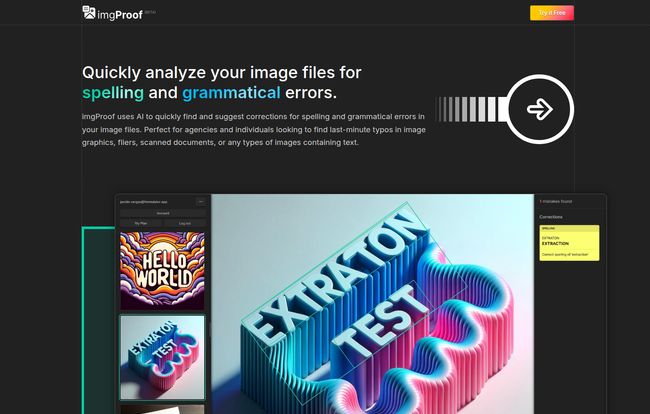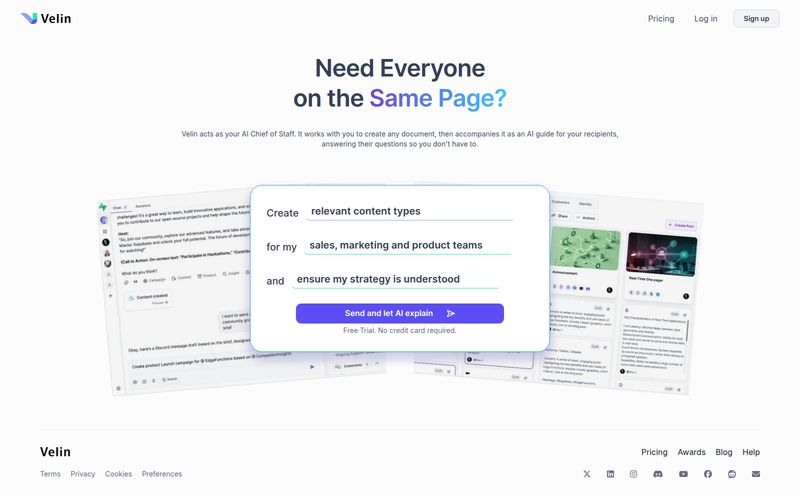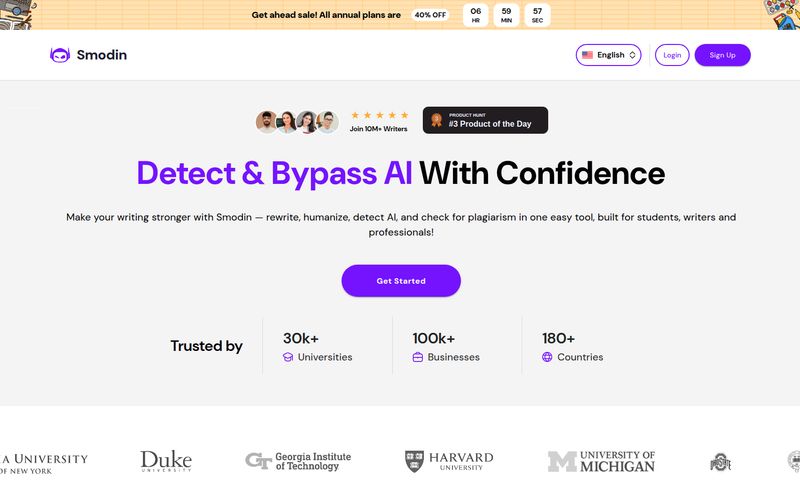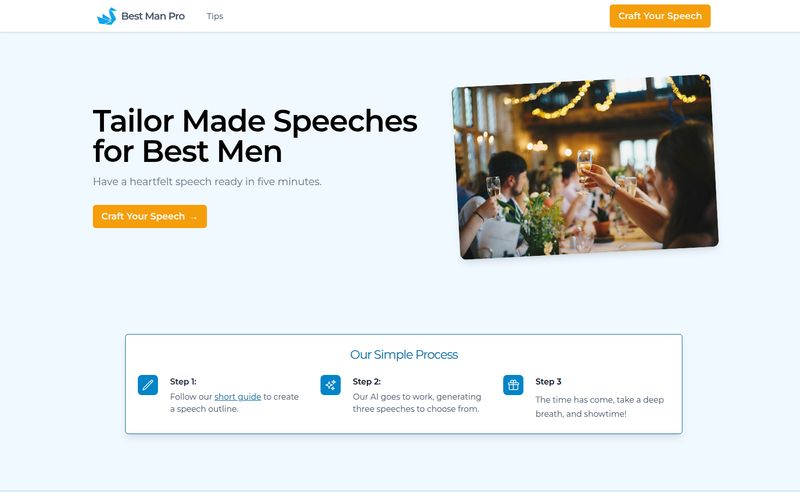We’ve all been there. You’ve spent hours, maybe even days, perfecting a beautiful graphic for a social media campaign, a client presentation, or a blog post header. You’ve tweaked the colors, aligned the elements to the pixel, and picked the perfect font. You hit export, upload it, and send it off into the world. And then you see it. That one, glaring, soul-crushing typo. Maybe it’s a “your” instead of a “you’re,” or a simple misspelling of “opportunity.” That sinking feeling in your stomach is universal, my friend.
For years, the process has been painfully manual. You write the copy in a doc, run a spell check, then paste it into your design software. Or worse, you eyeball the text directly in the image file, hoping your tired brain catches everything. It's a system just begging for human error. So when I stumbled upon a tool called imgProof that claims to automate this whole mess, my inner SEO and content nerd sat up a little straighter. An AI that proofreads images? Sign me up for a test drive.
So, What Exactly is imgProof?
In the simplest terms, imgProof is an automated image proofreader. You feed it an image file—like a JPEG, PNG, or WEBP—and its AI brain gets to work. It uses some pretty slick Optical Character Recognition (OCR) to read the text embedded within your graphic, no matter how fancy or stylized the font is. Then, it runs that text through a spelling and grammar check, flagging any mistakes.
But here’s the clever part. It doesn't just give you a boring list of errors. It presents the corrections in a simple, intuitive sticky note format right next to your image. It’s like having a meticulous editor leaning over your shoulder, popping a Post-it note on the screen wherever you’ve slipped up. It’s designed to completely digitize a process that, for many of us, still involves squinting at a screen and hoping for the best.

Visit imgProof
The All-Too-Familiar Pain of Manual Proofreading
Before we go further, let's just sit with the problem for a moment. Why does a tool like this even need to exist? Because the old way is broken. I’ve worked in agencies where the workflow for a single social media graphic involved a copywriter, a designer, and a project manager. The copy would be written in a Google Doc, approved, then sent to the designer. The designer would create the graphic, export a draft, and send it back for review. The PM and copywriter would look it over, maybe find a mistake, and send notes back. Repeat two or three times.
It's slow. It’s inefficient. It's a massive time-sink that adds up across dozens or hundreds of assets. And even with all those eyes on it, mistakes still slip through. A tool that can short-circuit that entire feedback loop is more than just a convenience; it’s a genuine money-saver.
A Look at the Key Features
I kicked the tires on imgProof, and a few things really stood out. It’s not just a one-trick pony.
AI-Powered Grammar and Spell Checking
This is the core of the whole thing. It goes beyond a basic dictionary check and gets into the context of your sentences. It's aiming to catch those grammatical goofs that a simple spellchecker might miss, which is a huge plus for anyone writing more than a couple of words on their graphics.
The Magic of Advanced OCR
Let's be honest, standard OCR can be a bit… clumsy. It often gets tripped up by creative fonts, weird spacing, or text on a busy background. imgProof claims to have “Advanced character recognition,” and from my tests, it holds up pretty well. I fed it an image with a slightly wacky, stylized script font that I was sure would break it, but it pulled the text out almost flawlessly. This is a big deal for designers who don’t want to sacrifice creativity for the sake of an algorithm.
It’s Multilingual, Baby!
This was a pleasant surprise. The tool can automatically identify the language in your image and proofread it accordingly. For agencies and businesses with a global audience, this is fantastic. No more needing separate, specialized workflows for Spanish, French, or German content. You can just toss the image in and let the AI figure it out. Big win.
All Your Favorite Formats Are Welcome
It handles the big three: JPEG, PNG, and WEBP. This covers pretty much 99% of the raster image formats that marketers and designers use daily. No need to convert files or jump through hoops, which is exactly what you want from a tool that's supposed to save you time.
My Hands-On Experience with the Interface
Using imgProof is dead simple. You land on the page, you upload your image, and you wait a few seconds. That’s it. The results pop up with your image on one side and the little yellow sticky notes on the other, detailing the suggested corrections.
“I have to say, the sticky note interface is a touch of genius. It feels less like a cold, correcting robot and more like a helpful colleague leaving a note. It’s friendly, non-judgmental, and incredibly easy to parse.”
I uploaded a recent blog thumbnail where I knew I’d typed “comlementary” instead of “complementary.” My own eyes had glazed right over it a dozen times. Boom. imgProof caught it instantly. Its a small thing, but those small things are what separate professional-looking content from amateur hour.
The Good, The Bad, and The Price Tag Mystery
No tool is perfect, right? So let’s break it down. The big advantage is obviously the speed and efficiency. It turns a potential 15-minute email chain into a 30-second task. It saves you from the potential embarrassment and cost of having to fix and re-upload a graphic after it's already gone live. The multi-language support and strong OCR are also massive pluses.
Now, for the downsides. First, let's talk about the elephant in the room: the price. I went looking for the pricing page to see what this would cost a freelancer or a small agency, and... well, it seems to be playing a game of hide and seek. I literally hit a 404 “Not Found” page. This is a pet peeve of mine, and I know I'm not alone. In an era of transparent, SaaS pricing, hiding the cost just creates a barrier. I hope they fix this soon, because it's the biggest question mark hanging over an otherwise impressive tool.
Second, and this is true of any OCR-based tool, its accuracy is dependent on the quality of your image. If your text is super low-res, heavily distorted, or blended almost perfectly with a chaotic background, the AI is going to have a tough time. Garbage In, Garbage Out—the old tech proverb holds true.
Who Is This Tool Really For?
I can see a few groups getting a ton of value out of imgProof:
- Social Media Managers: Juggling dozens of graphics a week for multiple platforms? This is your new best friend.
- Graphic Designers: Focus on designing, not proofreading. Use this as a final sanity check before you send off your drafts.
- Marketing Agencies: Streamline your QA process and reduce the back-and-forth between your copy and design teams.
- Content Creators & Bloggers: For people like me who create their own thumbnails and promotional images, it’s a fantastic safety net.
Basically, if you create images with text on them, this tool is probably for you.
Frequently Asked Questions About imgProof
How does imgProof handle different languages?
imgProof features automatic language identification. You can simply upload your image, and the AI will detect the language of the text and apply the appropriate spelling and grammar rules for proofreading.
What image file types does imgProof support?
It currently supports the most common web image formats: JPEG, PNG, and WEBP.
Is imgProof 100% accurate?
While it is very accurate, no AI is perfect. Its performance depends on the clarity and resolution of the text in your image. It’s best used as a powerful second set of eyes, not as a complete replacement for a final human check on critical projects.
Where can I find the pricing for imgProof?
As of this writing, the pricing information is not publicly available on their website. The pricing page link appears to be broken, which is a notable drawback.
Is this better than a normal spell check in Word or Google Docs?
It solves a different problem. A standard spell checker is great for your source text, but it can't help you if a typo is introduced during the design phase (e.g., a copy-paste error, a manual tweak). imgProof checks the final image, which is the version your audience will actually see.
My Final Verdict
So, will I be keeping imgProof in my digital toolkit? Absolutely. Despite the mysterious pricing, the core function is incredibly solid and solves a real, nagging problem for anyone in the digital content space. It’s a specialized tool that does one thing, and it does it very well.
It’s a safety net, a time-saver, and a potential face-saver all rolled into one. If you’ve ever felt that jolt of panic from spotting a typo in a published graphic, I’d say giving imgProof a try is a no-brainer. Go upload an old graphic and see what it catches. You might be surprised.



